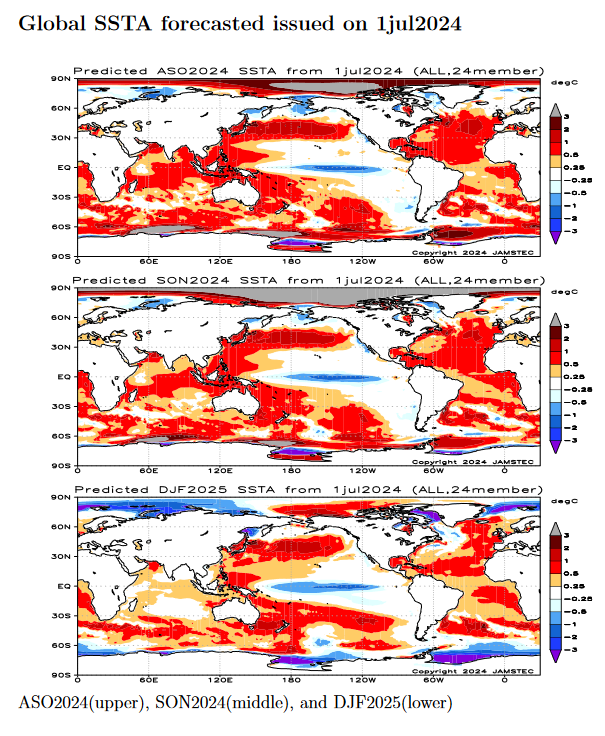Today Through the Fourth Friday (22 to 28 days) Weather Outlook for the U.S. and a Six-Day Forecast for the World: posted July 29, 2024
This article focuses on what we are paying attention to in the next 48 to 72 hours. The article also includes weather maps for longer-term U.S. outlooks and a six-day World weather outlook which can be very useful for travelers.
First the NWS Short Range Forecast. The afternoon NWS text update can be found here after about 4 p.m. New York time but it is unlikely to have changed very much from the morning update. The images in this article automatically update.
Short Range Forecast Discussion
NWS Weather Prediction Center College Park MD
Mon Jul 29 2024
Valid 12Z Mon Jul 29 2024 – 12Z Wed Jul 31 2024…Flash flooding possible in the Ohio/Tennessee Valleys and
central/southern Appalachians through early this week……Scattered severe thunderstorms forecast across portions of the Northern
Plains Monday and Upper Midwest Tuesday……Dangerous mid-summer heat wave to begin expanding across the central
U.S. on Monday…Bouts of thunderstorms are expected to continue over portions of the
Ohio/Tennessee Valleys and spread further into the central/southern
Appalachians to start off the work week. An active upper-level pattern
featuring at least a couple shortwaves and an approaching surface frontal
system from the west will help to focus storm development over the
Ohio/Tennessee Valleys and eventually into the southern Appalachians
Monday. Plentiful moisture in place will also continue to lead to the
threat of heavier rain rates, with increasing storm coverage into the
evening and potential back building/repeated rounds of storms raising the
chance for locally heavy rainfall totals. As such, a Slight Risk of
Excessive Rainfall (level 2/4) is in place for the threat of some
scattered flash flooding. In addition, sufficient instability/shear will
be in place over the Ohio Valley for a couple more intense storms, as well
as the threat for a more organized storm complex later Monday evening. The
Storm Prediction Center has included a Slight Risk (level 2/5) for severe
weather as well mainly for the threat of damaging winds. A similar pattern
will be in place on Tuesday, with the focus shifting further into the
southern and central Appalachians as the upper-level energy and surface
frontal system move eastward. Another Slight Risk of Exessive Rainfall is
in effect here for additional instances of flash flooding. Outside of the
flash flooding threat, scattered thunderstorms with moderate to locally
heavy rainfall are expected more broadly over the Midwest/Southeast
Monday, and also over portions of New England as a coastal low approaches.
Rain chances will expand over the Mid-Atlantic/Northeast as the system
approaches from the west on Tuesday. Forecast high temperatures across the
East will vary depending on cloud/storm coverage, with mostly mid-80s to
low 90s expected.Some additional storms will be possible further west along the frontal
boundary into the Upper Midwest and Northern Plains. Embedded upper-level
energy will help to trigger one round of storms over the Northern Plains
on Monday. Stronger upper-level flow will lead to more deep-layer shear
here than further east, with another Slight Risk of severe weather for the
threat of some very large hail as well as significant damaging winds if
storms consolidate/grow upscale into an organized system later in the
evening. Another round of severe weather is possible downstream over the
Upper Midwest Tuesday as yet another upper-level impulse helps to trigger
storms along the frontal boundary. Very high moisture will lead to strong
to extreme instability, with a Slight Risk in place for the chance of more
damaging winds.Outside of the severe weather threat, heat will become the big story more
broadly over the central U.S. over the next few days as an upper-level
high strengthens/expands over the region. Forecast high temperatures
Monday and Tuesday are expected to soar into the low to mid-100s over the
Central Plains, with upper-90s to low 100s to the west over much of the
High Plains, and mid- to upper 90s for the Middle and Lower Mississippi
Valley. High humidity values over the Mississippi Valley and eastern
portions of the plains will lead to heat indices in the 105-110 degree
range, potentially as high as 115 for some locations, with widespread
heat-related warnings/advisories in place. Warm morning lows only dropping
into the mid- to upper 70s will provide little relief from the heat
overnight. This combination of hotter temperatures to the west, higher
heat indices to the east, and the multi-day duration of this heat wave
will increase the danger not only to more sensitive groups, but also the
general public, particularly those without adequate air conditioning.A stagnant troughing pattern over the West will keep temperatures mostly
below average across the region, especially over portions of the Pacific
Northwest and northern Great Basin/Rockies. Forecast highs Monday-Tuesday
range between the 60s and 70s along the Pacific Coast, the 70s and 80s in
the Pacific Northwest and northern Great Basin/Rockies, the 80s and 90s
for interior California and the central Great Basin/Four Corners Region,
and 100s in the Desert Southwest. A cold front passing through the Pacific
Northwest will bring some rain chances on Monday, spreading into the
northern Rockies Tuesday. Smoke from area wildfires will also continue to
plague parts of the West, particularly over portions of the northern Great
Basin, resulting in poor air quality and areas of reduced visibility.



